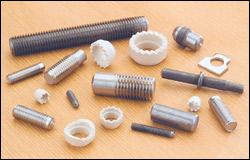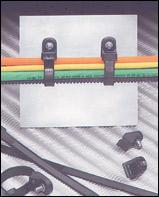
Compared with other welding and fastening processes, such as drilling and tapping, resistance welding, hand welding or clinch fastening, stud welding can be done faster with fewer steps. With no predrilling, punching or riveting required, the process yields significant productivity improvements and cost savings. At the same time, stud welding provides a high-quality attachment point that is secure and resists breaking or loosening.
In stud welding, a metal stud is joined to a metal workpiece by heating both parts with an arc of electricity. A key factor that differentiates stud welding from other fastening processes is that the fastener is attached to the workpiece without marring the other side.
There are two methods of stud welding: arc stud welding and capacitor discharge (CD) stud welding.
Arc Stud Welding
Arc stud welding is a highly reliable fastening method for a wide variety of applications. The process can quickly weld almost any size or configuration of metal stud to a workpiece, with maximum weld penetration and reliability.Arc stud welding creates strong, one-sided welds on base metals as thin as 0.048 inch. It produces welds in as little as 0.06 second. The process requires a DC power supply to create the arc; a stud welding gun; metal fasteners; and in some cases, ferrules.
There are three common techniques of arc stud welding: drawn arc stud welding, short arc stud welding and gas arc stud welding.
In the drawn arc technique, the stud is loaded into the chuck of the welding gun, and a ferrule (a disposable ceramic shield that contains the molten pool of metal) is placed over the end. The gun is placed against the workpiece. When the trigger is pressed, the DC power supply sends a signal that energizes the gun's internal lift mechanism, lifting the stud and drawing the pilot arc. The pilot arc establishes a path for the weld current, which initiates after the pilot arc. Upon completion of the correct arcing time, which is proportional to the square area of the surface being melted, the lift mechanism is de-energized. This causes the stud to plunge into the molten pool of metal. A plunge dampener is often used on larger studs to decelerate the stud's movement onto the molten pool. This minimizes splash. As the stud and the base metal join, the metal begins to solidify and the weld is created. The gun is lifted, and the ferrule is discarded.
The drawn arc technique uses flux embedded in the stud to cleanse the metal surface during the weld. During arcing, the flux is vaporized and reacts with the contaminating elements in the atmosphere to keep the weld zone clean.
The short arc technique is much like drawn arc, except that it uses no flux load or ferrule. This technique offers the shortest welding times of the arc stud welding techniques. It is characterized by high currents and short weld times. While it may be suitable for many high-volume applications, it can produce porous welds and should therefore be selected when speed and cost are a priority over weld strength. The short weld times minimize the effects of porosity, while the high current maintains the needed energy.
The gas arc technique uses inert shielding gas with no flux or ferrule, making it easier to automate. However, it provides less fillet control and less penetration depth compared with the drawn arc technique. In gas arc welding, a spark shield, which delivers the gas, replaces the ferrule. The stud is loaded and the gun is positioned for welding. When the user pulls the trigger, shielding gas floods the welding zone. The stud is lifted, and an arc is generated. While the stud remains lifted, the weld current melts the stud and base metal. When the arc time is complete, the stud is plunged into the molten pool. More gas is blown onto the weld, flowing until the molten metal cools. The gun can then be removed. Because no ferrule is used, this process lends itself well to automation and robotics.
Arc Stud Welding Advantages
Arc stud welding provides excellent welding success under a broad range of conditions. It produces a full cross-sectional weld, forming a bond that is stronger than the surrounding metal.Arc stud welding produces a strong, one-sided weld. The welds are vibration-proof and resist breaking, loosening or weakening. In applications where quality is measured in part by attractive appearance, arc stud welding offers excellent cosmetic appeal because the reverse side is not marred. Finally, because arc stud welding is a one-sided fastening process, it gives engineers greater design versatility.
Compared with other fastening processes, arc stud welding is faster and easier. Each weld is achieved in less than a second, and the process requires access to only one side. Arc stud welding eliminates punching, drilling, tapping and riveting. With special techniques, it can be performed on painted surfaces, eliminating the need for grinding and recoating.
Labor costs are dramatically reduced with arc stud welding because through-hole preparation is eliminated and the process can be completed by a single worker. Often, an expensive, odd-shaped piece can be duplicated inexpensively by welding several studs to a simple stock shape to form a metal fabrication.
CD Stud Welding
CD stud welding joins small-diameter studs to thin, lightweight materials. The weld cycle can be completed in 0.01 second on material as thin as 0.02 inch. These fast weld times minimize heat buildup, resulting in welds with very little distortion, discoloration or burning. This process is often used when appearance is a critical product feature.CD stud welding is similar to arc stud welding, except that it uses a capacitor storage system to produce a rapid electrical discharge. No ferrules or flux are needed. The process is used mainly for welding mild steel, stainless steel and aluminum studs.
There are two primary techniques for CD stud welding: contact and gap. Both require a specially designed stud with a projection, or ignition tip, on the end to be welded. This tip provides accurate welding time control with precise repeatability.
In the contact technique, the stud is loaded into the gun and positioned in contact with the workpiece. Energy is then instantaneously discharged from capacitors through the stud's projection. Because the size of the ignition tip cannot handle the current density of the capacitor's stored energy, it vaporizes, creating a gap that allows an arc to be formed. As the arc begins to melt the stud and workpiece, the two pieces are forced together, and a weld is produced as the metal cools.
Compared with the contact technique, the gap technique offers shorter weld times with higher current densities. With such quick welding capability, this technique is particularly well-suited to cosmetic applications, because it produces very minimal backside marking.
In the gap technique, the stud is positioned above, not against, the workpiece. When the stud is released, it accelerates toward the workpiece. Simultaneously, an open-circuit voltage is applied to the gap. As in the contact technique, the ignition tip is vaporized and the pieces are melted and forced together to form the weld. Because the stud starts in motion during this welding technique, the weld times are even faster than with the contact technique--approximately 0.004 second with a peak current of 9,000 amps.
The gap technique is ideal when welding aluminum or nonferrous alloys, which have an excellent ability to conduct heat. With slower techniques, the base material can draw heat away too fast for a weld to occur. Because it's so fast, the gap technique overcomes this phenomenon.
CD Stud Welding Advantages
CD stud welding creates high integrity welds even on thin gauge materials. Additionally, it can weld dissimilar metals because the weld penetration is so slight that metallurgical problems are prevented.Joints created with CD stud welding have an attractive appearance with minimal burn, which is often important in cosmetic applications. The process creates one-sided welds with no reverse side dimples. In fact, the back side of the product can be prepainted without risking damage to the finish after welding.
CD stud welding creates strong, high-quality bonds on very lightweight material. It's also very fast, which increases productivity.
As in arc stud welding, CD stud welding saves significant costs by eliminating through-hole preparation. Fewer assembly steps are re-quired, because CD stud welding eliminates punching, drilling, tapping and riveting.

Stud Welding Applications
With an automatic feeder, a stud welder can be integrated with an automated assembly machine to yield weld rates of up to 45 studs per minute, depending on size and process.Arc stud welding is used in a wide range of applications.
In the automotive industry, the process is used to assemble heat shields, power steering and dashboard components, instrument panels, insulation, exhaust systems, lighting systems, brake lines, trim and electrical wire routing.
In the farm equipment industry, it's used to assemble fenders, brackets, cabs, spreaders, shrouding, thresher teeth, wiring and hose management parts. It's also used in lawn and garden equipment, such as tractors, mowers and seeders.
In the construction equipment industry, it's used to make cover plates, non-skid devices, and wiring and hose management parts.
In the commercial appliance industry, it's used in commercial dishwashers, bottle washers, cooking equipment and griddle plate assemblies.
Furniture manufacturers use it for metal household and office furniture, lawn furniture, shelving and racks.
Assemblers of fabricated metal products use arc stud welding in barbecue equipment, enclosures, plumbing apparatus, insulation enclosures, heating, ventilation and air-conditioning units, and water storage systems.
In the industrial equipment industry, arc stud welding is used to assemble inspection cover plate attachments, enclosures, flow indicators, material handling equipment and controls. It's also used for power transformer tanks and transducers.
Shipbuilders use it to attach insulation, wire management devices and hatch covers.
Providing fast welds on lightweight material with minimal distortion, CD stud welding is widely used in:
- Jewelry, such as earrings and pins.
- Hardware, such as brackets, cleats and tool handles.
- Cookware, such as utensils, pots, pans and handles.
- Electrical housewares, such as electric frying pans, cookers, oven assemblies and microwave guides.
- Electrical and electronic devices, such as components, terminals, pumps, motors, communication equipment, and electronic systems.
- Doors, such as commercial doors, escutcheon plates and insulation.




